江苏省海安县大公初级中学八年级英语上册《8A Unit 3 A day out》Period 5 Grammar(2)教案 牛津版
8A Unit 3 vocabulary
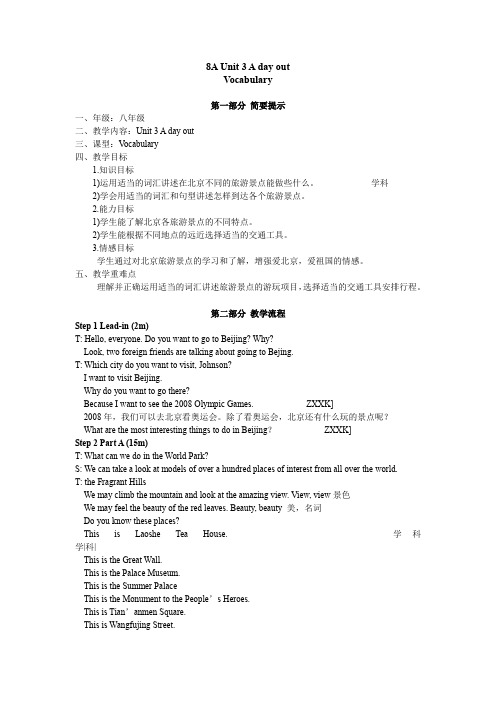
8A Unit 3 A day outVocabulary第一部分简要提示一、年级:八年级二、教学内容:Unit 3 A day out三、课型:V ocabulary四、教学目标1.知识目标1)运用适当的词汇讲述在北京不同的旅游景点能做些什么。
学科2)学会用适当的词汇和句型讲述怎样到达各个旅游景点。
2.能力目标1)学生能了解北京各旅游景点的不同特点。
2)学生能根据不同地点的远近选择适当的交通工具。
3.情感目标学生通过对北京旅游景点的学习和了解,增强爱北京,爱祖国的情感。
五、教学重难点理解并正确运用适当的词汇讲述旅游景点的游玩项目,选择适当的交通工具安排行程。
第二部分教学流程Step 1 Lead-in (2m)T: Hello, everyone. Do you want to go to Beijing? Why?Look, two foreign friends are talking about going to Bejing.T: Which city do you want to visit, Johnson?I want to visit Beijing.Why do you want to go there?Because I want to see the 2008 Olympic Games. ZXXK]2008年,我们可以去北京看奥运会。
除了看奥运会,北京还有什么玩的景点呢?What are the most interesting things to do in Beijing?ZXXK]Step 2 Part A (15m)T: What can we do in the World Park?S: We can take a look at models of over a hundred places of interest from all over the world.T: the Fragrant HillsWe may climb the mountain and look at the amazing view. View, view景色We may feel the beauty of the red leaves. Beauty, beauty 美,名词Do you know these places?This is Laoshe Tea House. 学科学|科|This is the Great Wall.This is the Palace Museum.This is the Summer PalaceThis is the Monument to the People’s Heroes.This is Tian’anmen Square.This is Wangfujing Street.T: What can we do in these places? Open you books and turn to page 44.Part AKitty wants to take Linda out. She made a list of things that Linda might like to do. Help Kitty complete the list. Use the names from the box.Kitty 想带Linda游览北京,请将方框中的名称填在横线上,帮助Kitty完成游览清单。
八年级英语上册Unit3Adayout练习牛津版(2021年整理)

A. The more Jack explained, the angrier the couple got.
B。 Jack wanted to show his feelings through words after his experience。
Last year Jean made a very special friend on QQ。 His name was David and lived in San Francisco. David was full of stories and jokes. He and Jean had a common(共同的) interest in rock music and modern dance. So it always took them hours to talk happily on QQ and sometimes they even forgot their time. Of course, they wanted to know more about each other. David sent a picture of himself: He was a tall, good—looking young man with a big, happy smile。 As time went by, they became good friends and often sent cards and small things to each other.
C。 fewer mistakesD。 more mistake
题六:
翻译:
我的故事书比你的多。
他的零用钱比你的少。
初二英语上册8A Unit 3 A day out教学案
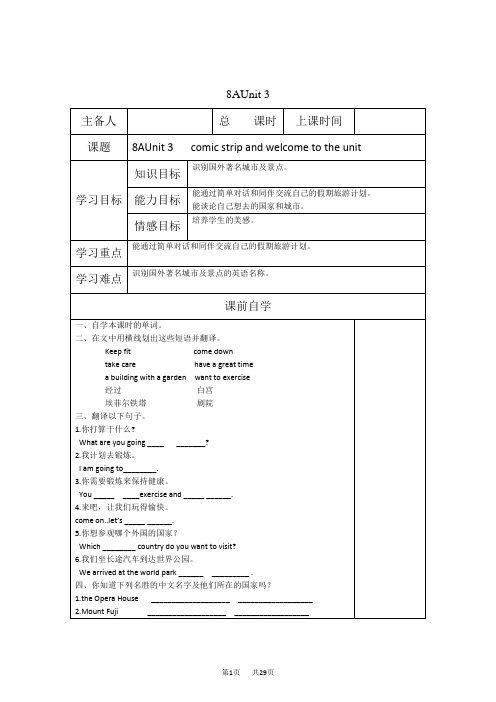
8AUnit 3导学案导学案导学案导学案导学案导学案导学案导学案导学案8A Unit 3参考答案导学案1一、1.boat past 2.coffee 3.president 4.with 5.foreign二、1. How did you arrive at the World Park?2.I took a boat trip under the famous Harbour Bridge and went past the Opera House.3.Did you have a good time when you went out?4.What were they doing when you went past?三、C B C B导学案2一、略。
二、1.School trip 2.coach 3.traffic 4.better 5.eodels8.interest 9.amazing三、1.Luckily 2.began 3.chose 4.to visit 5.to lend6.amazing7.taught8.yourself9.beauty 10.saw导学案3一、略二、1.they their 2. us 3.ourselves 4.yourself 5.my 6.yours 7.themselves8.our 9.hers 10. you your mine导学案4一、1.boring 2.invited 3.world 4.beauty 5.traffic二、1.What do you think of the trip?2.How far is it from the school to the park?3.He often goes to New York by plane.4.I go home on my foot after school every day.5. She sometimes rides a bike to school.三、1.take underground to World Park 2.over hundred places interest have no idea3.be careful too much traffic4.at the beginning of the meeting, sang5.on English, grades in导学案5一、1.but 2.or 3.and 4.or 5.and 6.but 7.but二、1. We can go to the Eiffel Tower or visit the pyramids first.2. The music was great but too loud.3. The Golden Gate Bridge was small and looked just like the one in America.4. Would you like some pears or grapes?5. spent on6.take an underground三、1.to go 2. to go 3.passing 4. not to cross5. play6. to buy7.don’t watch8. have四、1. you can go to Sanya or Guilin in the summer holiday.2. They are planning to go travelling tomorrow.3. Look! The children are playing hide-and-seek.4. Jack taught himself how to make a home page last year.导学案 6一、略二、1.help yourselves to 2.will hurt yourself 3.taught herself4.is pulling himself5.enjoyed ourselves6. by himself三、1.himself 2.myself 3.themselves 4. myself 5.themselves四、1.are preparing for 2.to stay at home, of going travelling, too much homework.3.to keep secret for each other4.Jiang Ming is ill now, and he can’t go to school.5.go swimming or fishing6.decided to7.planning for a really interesting trip.8.but he can’t solve the problem.导学案7一、1.cheerful 2.winners 3.final 4.supporters 5. receiving 6.cost7. sure 8.arrives 9.per 10.half-time二、1.more than two 2.cost him 3. which sportswoman to support 4.with many useful5.why not go/what about going三、go go go go going导学案8一、1.fact 2.opinion 3.fact 4.opinion 5.opinion二、1.preparing 2.invited 3.eazing三、1.to keep fit 2.taught himself 3. take photos 4.is knocking at5. hide-and-seek四、1.ourselves 2.beginning 3.watched 4.are going to fly 5. unpopular导学案9一、略二、1.tries his best to 2.taught himself, home page 3.so many places of interest4. want to take, sunset5.climbs the rocks导学案10一、1. It is sunny and our city looks more beautiful.2. He invited me to the morning assembly but I am too busy to go.3. On Sunday you can go horse riding or listen to pop music at home.4. The little boy is very young but knows more things than the other children.5. My mother can do cooking for me at home or I can go to the restaurant for supper.二、1.stay 2.to do 3.to become to treat 4.to go 5.to pull三、1.yourselves 2.yourself 3.themselves 4.ourselves 5.himself6.myself7.itself8.myself9.himself四、略8A Unit4。
江苏省海安县大公初级中学八年级英语上册《8A Unit 3 A day out》Period 4 Grammar(1)教案 牛津版
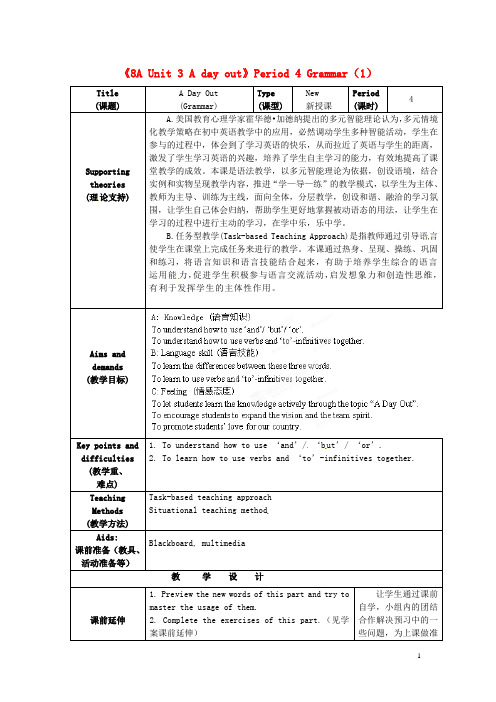
《8A Unit 3 A day out》Period 4 Grammar(1)Title (课题)A Day Out(Grammar)Type(课型)New新授课Period(课时)4Supporting theories (理论支持)A.美国教育心理学家霍华德•加德纳提出的多元智能理论认为,多元情境化教学策略在初中英语教学中的应用,必然调动学生多种智能活动,学生在参与的过程中,体会到了学习英语的快乐,从而拉近了英语与学生的距离,激发了学生学习英语的兴趣,培养了学生自主学习的能力,有效地提高了课堂教学的成效。
本课是语法教学,以多元智能理论为依据,创设语境,结合实例和实物呈现教学内容,推进“学—导—练”的教学模式,以学生为主体、教师为主导、训练为主线,面向全体,分层教学,创设和谐、融洽的学习氛围,让学生自己体会归纳,帮助学生更好地掌握被动语态的用法,让学生在学习的过程中进行主动的学习,在学中乐,乐中学。
B.任务型教学(Task-based Teaching Approach)是指教师通过引导语言使学生在课堂上完成任务来进行的教学。
本课通过热身、呈现、操练、巩固和练习,将语言知识和语言技能结合起来,有助于培养学生综合的语言运用能力,促进学生积极参与语言交流活动,启发想象力和创造性思维,有利于发挥学生的主体性作用。
Aims and demands (教学目标)Key points and difficulties(教学重、难点) 1. To understand how to use ‘and’/‘b ut’/ ‘or’.2. To learn how to use verbs and ‘to’-infinitives together.Teaching Methods (教学方法) Task-based teaching approach Situational teaching methodAids:课前准备(教具、活动准备等)Blackboard, multimedia教学设计课前延伸1. Preview the new words of this part and try tomaster the usage of them.2. Complete the exercises of this part.(见学案课前延伸)让学生通过课前自学,小组内的团结合作解决预习中的一些问题,为上课做准备Teaching Plan (授课计划) Studying Plan(学习计划)Aims(设计意图)课内探究课内探究学StepⅠWarm up温故知新,自然导入新句型。
八年级英语上册《Unit 3 A day out(第3课时)》教案

feel sick a main road between cities
at the beginning (反) lots of ca rs, buses, and trucks on roads
(1) It took half an hour to get to the World Pa rk from school. F
A day out
教学目标
1.读懂文章,了解此次游玩的基本情况
2 .复习和拓展有关世界名胜的知识。
教学重难点
学会用正确的形容词描述旅游的感受 。
集体备课
二次备课
教学过程:
一、教师解释课文中的重点、难点内容。
co achn. a bus (usu al ly with a single desk) for carrying passengers over long distances(长途汽车) by coach
教后记:
highwayn.(especially US) a main road between cities(城镇间的公路)
on the hiБайду номын сангаасhway
tripn.(travel from one place to another)
take a (school) trip to sw / go on a trip to / travel to sw / go travelling
成五大组,呈现表格,给每组的各个学生安排一个部分,让他们寻找描述Linda当天在不同地点所见到的人或物及不同阶段感受的形容词。
(2) Linda’s feeling:
At the beginning:Bored; sick
江苏省海安县大公初级中学八年级英语上册《8A Unit 3 A day out》Period 2 Reading(1)学案
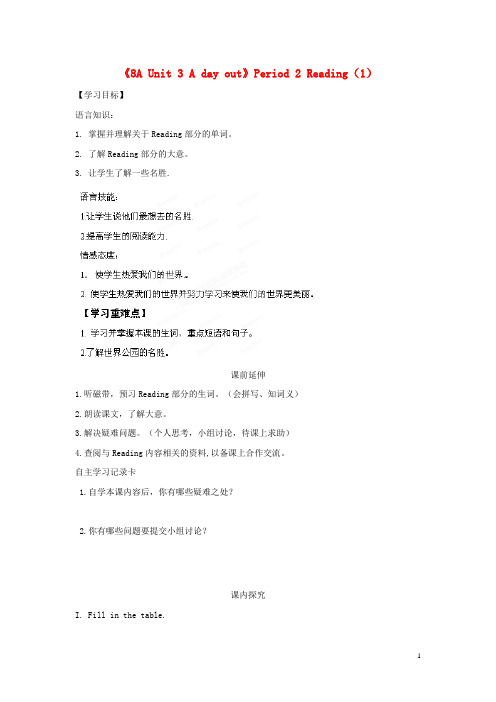
《8A Unit 3 A day out》Period 2 Reading(1)【学习目标】语言知识:1. 掌握并理解关于Reading部分的单词。
2. 了解Reading部分的大意。
3. 让学生了解一些名胜.课前延伸1.听磁带,预习Reading部分的生词。
(会拼写、知词义)2.朗读课文,了解大意。
3.解决疑难问题。
(个人思考,小组讨论,待课上求助)4.查阅与Reading内容相关的资料,以备课上合作交流。
自主学习记录卡1.自学本课内容后,你有哪些疑难之处?2.你有哪些问题要提交小组讨论?课内探究I. Fill in the table.Keys: Linda and the class 1, Grade 8 students; October 24th; by coach; two ours by coach; fine; boring, sick; excite dII. Do questions and answers.1. Did Linda and Kitty meet Mr. Wu and other students at the bus stop?2. Wher e did Linda see a lot of traffic, on the highway or on the city roads?3. Did Linda see the Golden Gate Bridge from the coach at the gate of the park?4. The best part was the song and dance parade, wasn’t it?Keys: 1.No. 2.On the city roads 3.No. 4.yesI II. Write a T if it is true, write an F if it is false.1. It took half an hour to get to the World Park from school.2. We went to the World Park by coach from Sunshine Town.3. We could see the pyramids from the coach4. There are many places of interest there5. The pyramids looked just like the real ones in the USA.6. There is a tall stone building called the Eiffel Tower.7. Daniel made a special home page for the tripKeys: 1.F 2.F 3.F 4.T 5.F 6.F 7.FIV. Do questions and answers.1. When did Linda have the trip?2 .How did they go on the trip?3. Did Linda feel well all the time during the trip?4. What was in the park?5. What was the best part of that day?6. Could Linda’s mother see the photos?Keys: 1. Yesterday (October 24th) 2.By coach. 3.No.4. The models of the places of interest from the whole world.5. The song and dance parade.6. Ye sV. Some phrases.1.到达___________________2.加入他们的旅行团____________3.过得愉快___________________4.不再_______________________5.环游世界___________________6.交通拥挤___________________7.在高速公路上________________ 8.邀请某人做某事______________Keys: 1. arrive in/at 2. join their school trip 3. enjoy oneself 4. not any more 5. travel around the world 6. a lot of traffic 7. on the highway 8. invite sb. To do sthVI. Let’s retell the text.1. I’m … time here. I went to….2. Kitty’s teacher… invite… to … trip to…3. It was…but… at the beginning.4. Yesterday morning Mr. Wu and …met…and…at…5. Then we…..6. The trip from…took…by…7. It was… 8. There was…on… but… when…9. Kitty and I felt… for … 10. Finally, we…11.The sky was…and everything. We became…when we…from…!12. It’s…metal and… 13.When…, we all…quickly.14.Kitty and I …not …any more. 15. We just wanted… and …16. The Soon, we were… 17.whole…was… us.18. They are over… from… 19. The…looked just like…in…20.The…looked just like…too. 21. When I …, I couldn’t…22.There were…! 23.It was …day but the best part was…24.The music was …and Kitty wanted… 25.You ca n …on the Internet.26. Daniel taught…to… 27. He p ut…on it for everyone to…28.Go and see…yourself.VII. Some exercises1. Shanghai is one of the biggest c__________ in China.2. The Eiffel Tower is made of m__________.3. There are some ki tes flying in the s_________.4. We saw many places of i_________ from all over the world.5. I’d like to i_________ my friends to my party.6.At the _____________(开始), I didn’t like this subject.7.Help __________(你们自己) to some fish, children.8.There is a lot of _________(车辆) on the road.9.My sister always feels _____(恶心,不舒服) when she takes a bus.10.We often travel by_______(长途汽车)Keys:1. cities 2. metal 3. sky 4.interest 5.invite 6. beginning 7. yourselves 8. traffic 9.sick 10.coach课后提升。
级上册Unit3《Adayout》(Reading2)课件

Write an e-mail to your close friend to tell him/her your pleasant trip to a place of interest.
T
Fill in blanks
I was very happy that day because my teacher
Mr Wu _in_v_i_te_d_ my cousin Linda to _j_oi_n__ in our school trip. At first we felt b_o_r_i_n_g because there was heavy _tr_a_f_fi_c on the way. Finally we__ar_r_i_veadt
B: I am going to Beijing in… A: How are you going there? B: I am going there by plane. A: What are you going to visit there?
B: I am going to visit the Great Wall.
over the world. We also saw the song and
dance_s_h_o_w_s. We really enjoyed o_u_r_s_el_veosn that _am__a_z_in_gday.
After our trip, Daniel p_u__t __ a home page on the
8.整个世界 9.在我们面前 10.名胜古迹 11.由……制作的 12. 和……一样伟大 13. 主要风景 14. 在他的和主页上
the whole world in front of us places of interest be made of as great as... The main sights on his home page
江苏省海安县大公初级中学八年级英语上册《8A Unit 3
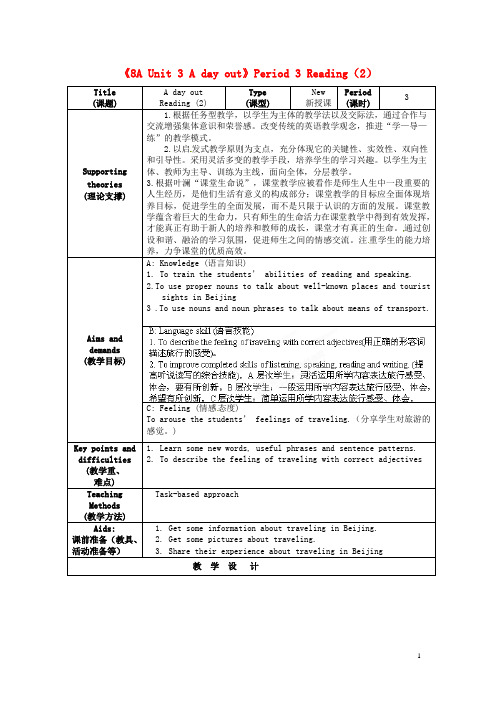
《8A Unit 3 A day out》Period 3 Reading(2)Title (课题)A day outReading (2)Type(课型)New新授课Period(课时)3Supporting theories (理论支撑)1.根据任务型教学,以学生为主体的教学法以及交际法,通过合作与交流增强集体意识和荣誉感。
改变传统的英语教学观念,推进“学—导—练”的教学模式。
2.以启发式教学原则为支点,充分体现它的关键性、实效性、双向性和引导性。
采用灵活多变的教学手段,培养学生的学习兴趣。
以学生为主体、教师为主导、训练为主线,面向全体,分层教学。
3.根据叶澜“课堂生命说”,课堂教学应被看作是师生人生中一段重要的人生经历,是他们生活有意义的构成部分;课堂教学的目标应全面体现培养目标,促进学生的全面发展,而不是只限于认识的方面的发展。
课堂教学蕴含着巨大的生命力,只有师生的生命活力在课堂教学中得到有效发挥,才能真正有助于新人的培养和教师的成长,课堂才有真正的生命。
通过创设和谐、融洽的学习氛围,促进师生之间的情感交流。
注重学生的能力培养,力争课堂的优质高效。
Aims and demands (教学目标) A: Knowledge (语言知识)1. To train the students’ abilities of reading and speaking.2.To use proper nouns to talk about well-known places and touristsights in Beijing3 .To use nouns and noun phrases to talk about means of transport.C: Feeling (情感态度)To arouse the students’ feelings of traveling.(分享学生对旅游的感觉。
八年级英语上册 8A Unit 3 A day out Main task课件2 人教新目标版

Homework
Finish your writing after class.
___________ and we can _______________________
there. After lunch, we will _____________________.
Cost:
The cost is about _________.
Instructions:
We will make it a really fun day for everyone. If you want to come, please let me know as soon as possible. I hope that _________. Closing:
Take the ____ bus to Tian’anmen Square ____________________ See the Monument to the People’s Heroes Visit the People’s Great _____ Hall Take the bus to … ___________
Writing
Date: _______ Name of receiver: __________ Purpose of the letter:
_____ will go back to _____soon. We are planning
a day out for her. We want to invite you to go to ______________________ on ____________________ _____.
江苏省海安县大公初级中学八年级英语上册《8A Unit 3 A day out》Period 4 Grammar(1)学案(无答案) 牛
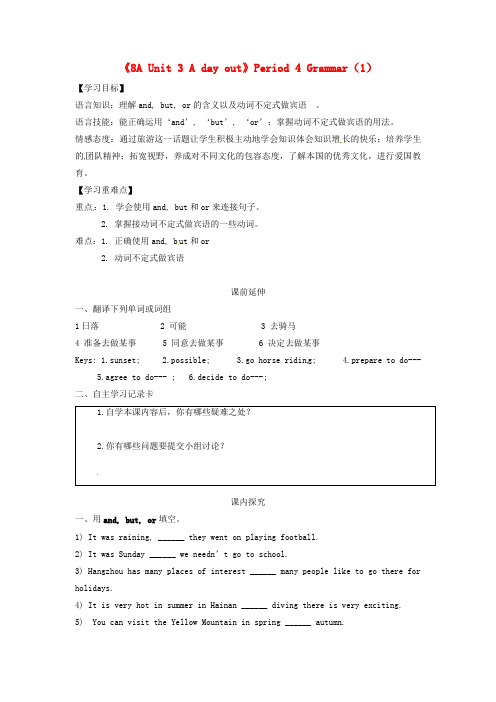
《8A Unit 3 A day out》Period 4 Grammar(1)【学习目标】语言知识:理解and, but, or的含义以及动词不定式做宾语。
语言技能:能正确运用‘and’, ‘but’, ‘or’;掌握动词不定式做宾语的用法。
情感态度:通过旅游这一话题让学生积极主动地学会知识体会知识增长的快乐;培养学生的团队精神;拓宽视野,养成对不同文化的包容态度,了解本国的优秀文化,进行爱国教育。
【学习重难点】重点:1. 学会使用and, but和or来连接句子。
2. 掌握接动词不定式做宾语的一些动词。
难点:1. 正确使用and, b ut和or2. 动词不定式做宾语课前延伸一、翻译下列单词或词组1日落 2 可能 3 去骑马4 准备去做某事5 同意去做某事6 决定去做某事Keys: 1.sunset; 2.possible; 3.go horse ridin g; 4.prepare to do---5.agree to do--- ;6.decide to do---;二、自主学习记录卡1.自学本课内容后,你有哪些疑难之处?2.你有哪些问题要提交小组讨论?课内探究一、用and, but, or填空。
1) It was raining, ______ they went on playing football.2) It was Sunday ______ we needn’t go to school.3) Hangzhou has many places of interest ______ many people like to go there for holidays.4) It is very hot in summer in Hainan ______ diving there is very exciting.5) You can visit the Yellow Mountain in spring ______ autumn.6) I like Hunan Road in Nanjing ______ only for shopping.7) The West Lake is large _______ beautiful.8) You can write to me _______ call me.9) I don’t like to play cards_______ chess.10) Be careful! _______you will fall off your bike.Keys: 1.but; 2.and; 3.and; 4.and; 5.or; 6.but; 7. and; 8.or; 9.or; 10.Or二、用动词的适当形式填空。
八年级英语上册《8A Unit 3 A day out》Period 1 Comic strip
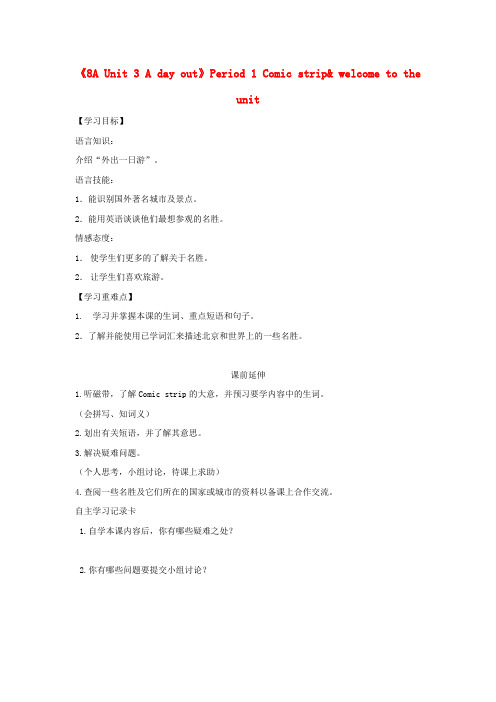
《8A Unit 3 A day out》Period 1 Comic strip& welcome to theunit【学习目标】语言知识:介绍“外出一日游”。
语言技能:1.能识别国外著名城市及景点。
2.能用英语谈谈他们最想参观的名胜。
情感态度:1.使学生们更多的了解关于名胜。
2.让学生们喜欢旅游。
【学习重难点】1. 学习并掌握本课的生词、重点短语和句子。
2.了解并能使用已学词汇来描述北京和世界上的一些名胜。
课前延伸1.听磁带,了解Comic strip的大意,并预习要学内容中的生词。
(会拼写、知词义)2.划出有关短语,并了解其意思。
3.解决疑难问题。
(个人思考,小组讨论,待课上求助)4.查阅一些名胜及它们所在的国家或城市的资料以备课上合作交流。
自主学习记录卡1.自学本课内容后,你有哪些疑难之处?2.你有哪些问题要提交小组讨论?课内探究1. Do questions and answers.(1) What place did Nick visit?(2) How did he travel?(3) Where did Leo write the postcard?(4) What did Jane think of the White House?Keys: (1) He visited the famous Harbour Bridge and the Opera House.(2) By boat.(3) In a little coffee shop by the River Seine.(4) It is a beautiful building with a big garden and many trees.2. Do some exercises.Eddie wants to e_____________ today. He says that he will c______ a hill. Hobo is very happy to hear that because he thinks that Eddie n______ to do that and k______ f_______. But Eddie says he just wants to e_________ but not k_____ f_____. Hobo can’t understand it, so he follows Eddie. To his surprise, he finds so much food like a hill outside and Eddie is shouting nearby, “Come on,let’s enjoy o__________.!”Keys: 2. exercise climb needs keeps fit exercise keep fit ourselves3. Translate some phrases.Keys: (1) climb a hill (2) need to exercise (3)keep fit (4)enjoy oneself (5) take a boat trip (6)take care (7)on the top of (8)the world map(9)白宫(10)美国总统(11)塞纳河(12)港湾大桥(13)埃菲尔铁塔(14)长城(15)悉尼歌剧院课后提升。
江苏省海安县大公初级中学八年级英语上册《8A Unit 3 A day out》Period 7 Main task教案 牛津版
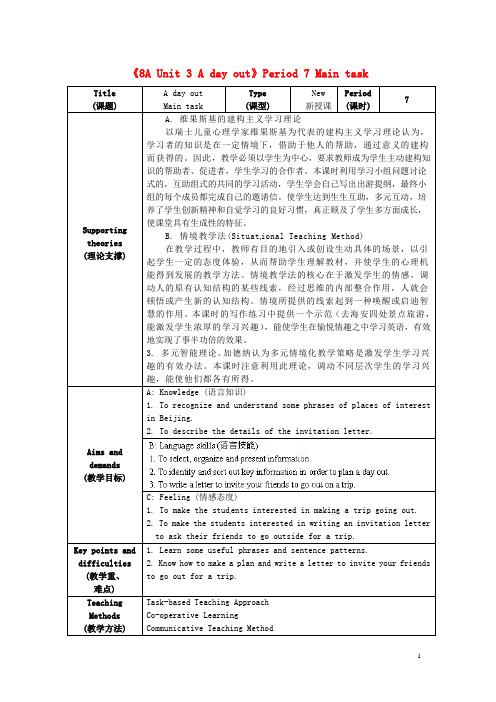
Aims and demands
(教学目标)ห้องสมุดไป่ตู้
A: Knowledge (语言知识)
1.To recognize and understand some phrases of places of interest inBeijing.
1) How many places of interest are they going to visit? What are they?
2) What will they do inBeihaiPark?
3) How will they get to thePalaceMuseumfrom Sunshine Underground Station?
B.情境教学法(Situat ional Teaching Method)
在教学过程中,教师有目的地引入或创设生动具体的场景,以引起学生一定的态度体验,从而帮助学生理解教材,并使学生的心理机能得到发展的教学方法。情境教学法的核心在于激发学生的情感,调动人的原有认知结构的某些线索,经过思维的内部整合作用,人就会顿悟或产生新的认知结构。情境所提供的线索起到一种唤醒或启迪智慧的作用。本课时的写作练习中提供一个示范(去海安四处景点旅游,能激发学生浓厚的学习兴趣),能使学生在愉悦情趣之中学习英语,有效地实现了事半功倍的效果。
2. Get some pictures of places of interest inBeijing.
教学设计
课前延伸
(预习)
1.阅读Kitty and Daniel’s plan for the trip(P53)和An invitation letter(P54),了解大意。
江苏省海安县大公初级中学八年级英语上册《8A Unit 3 A day out》Period 8 Checkout学案
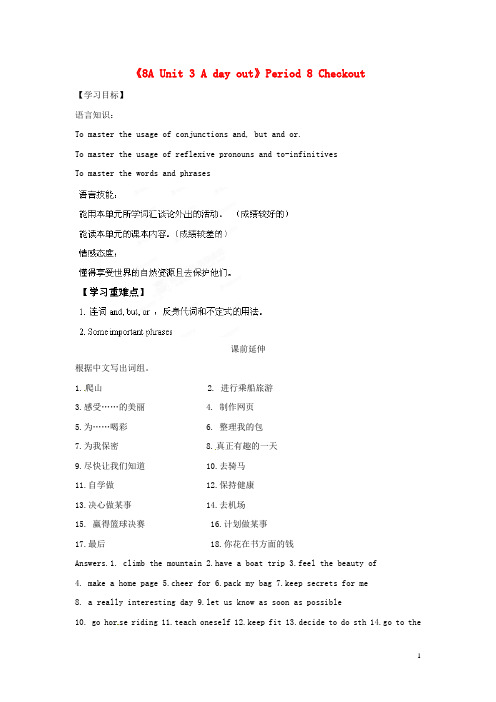
《8A Unit 3 A day out》Period 8 Checkout【学习目标】语言知识:To master the usage of conjunctions and, but and or.To master the usage of reflexive pronouns and to-infinitivesTo master the words and phrases课前延伸根据中文写出词组。
1.爬山2. 进行乘船旅游3.感受……的美丽4. 制作网页5.为……喝彩6. 整理我的包7.为我保密 8.真正有趣的一天9.尽快让我们知道 10.去骑马11.自学做 12.保持健康13.决心做某事 14.去机场15. 赢得篮球决赛 16.计划做某事17.最后 18.你花在书方面的钱Answers.1. climb the mountain 2.have a boat trip 3.feel the beauty of4. make a home page5.cheer for6.pack my bag7.keep secrets for me8. a really interesting day 9.let us know as soon as possible10. go hor se riding 11.teach oneself 12.keep fit 13.decide to do sth 14.go to theairport15. win the basketball final 16.plan to do sth 17.in the end 18. the money that you spend on books二、收集出游一些的资料。
三、完成Checkout书上练习。
自主学习记录卡课内探究一.Combine the following sentences.1. He is tall. He runs very fast.He is tall _______ he runs very fast.2. Jack is very small and thin. He can carry the heavy bag.Jack is very small and thin _______ he can carry the heavy bag.3. You can play basketball. You can go swimming.You can play basketball _____ you can go swimming.Answers: and, but, or二.复习反身代词。
江苏省八年级英语上册 Unit 3 A day out精美教案.doc

课题 课时 教学 目标
教学 重点 教学 难点 教学 媒体 教学 过程
Unit 3 A day out ---Welcome to the unit
第一课时
执教时间
复备人
1.知识目标:
a.学习词汇:ourselves, Australia, coffee, top, president, wide, steel, ton
How wide/long is…?
2.技能目标:能通过简单对话和同伴交流自己的假期旅游计划。
2.技能目标:能通过简单对话和同伴交流自己的假期旅游计划。
情感目标:学会与别人交流,分享快乐。
词汇识记运用,重点句型的运用。
Come on 在不同场合的不同意思。
录影机,多媒体,实物等
Step1:预习指导与检测 见导学案
arrive, interest, main, sights, culture, Internet, page,
yourselves, themselves
学习词组:arrive in/at, can’t wait,get off, place of interest, not believe
one’s eyes, home page, by oneself
2 Fi_n_i_s_h_the exercises in your exercise book .
教学反思
课题 Unit3 A day out ---Reading 1
课时 教学 目标
教学 重点 教学 难点 学法 指导 教学 过程
第二课时
执教时间
复备人
1.知识目标:
学习词汇:fine, join, myself, shine, clear, sky, journey, boring, finally,
江苏省海安县大公初级中学八年级英语上册《8A Unit 3 A day out》Period 5 Grammar(2)学案(无答案) 牛
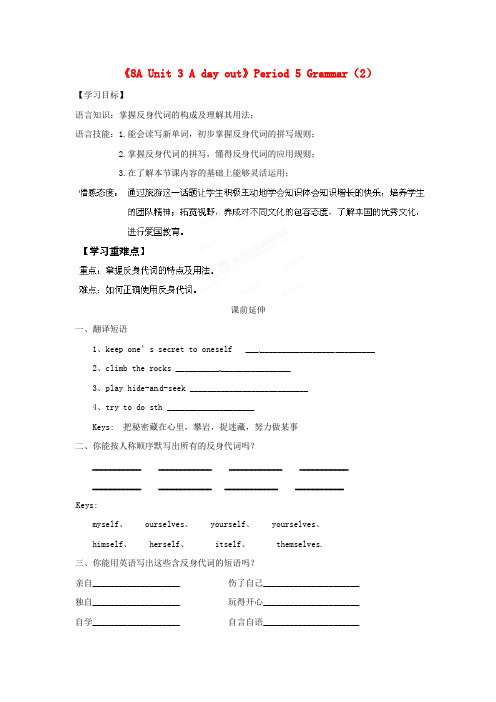
《8A Unit 3 A day out》Period 5 Grammar(2)【学习目标】语言知识:掌握反身代词的构成及理解其用法;语言技能:1.能会读写新单词,初步掌握反身代词的拼写规则;2.掌握反身代词的拼写,懂得反身代词的应用规则;3.在了解本节课内容的基础上能够灵活运用;课前延伸一、翻译短语1、keep one’s secret to oneself _____________________________2、climb the rocks __________________________3、play hide-an d-seek ___________________________4、try to do sth ____________________Keys: 把秘密藏在心里,攀岩,捉迷藏,努力做某事二、你能按人称顺序默写出所有的反身代词吗?___________ ____________ ____________ ______________________ ____________ ____________ ___________Keys:myself、 ourselves、 yourself、 yourselves、himself、 herself、 itself、 themselves.三、你能用英语写出这些含反身代词的短语吗?亲自____________________ 伤了自己______________________独自____________________ 玩得开心______________________自学____________________ 自言自语______________________请随便吃…_______________________ 迷路______________________照顾自己_________________________ 把秘密藏在心里____________________Keys: for oneself , hurt oneself , by oneself , enjoy oneself , teach oneself , say to oneself , help oneself to sth , lose oneself , look after oneself keep the secret to oneself自主学习记录卡1.自学本课内容后,你有哪些疑难之处?2.你有哪些问题要提交小组讨论?课内探究一、用反身代词翻译句子。
初二英语上册8A Unit 3 A day out教学设计英文

UNIT THREEPART ONE: TEACHING DESIGN第一部分:教学设计Unit Objectives●To use the vocabulary to identify and describe well-known places in Beijing and aroundthe world●To learn to make suggestions and arrangements●To learn to talk about different places using facts and opinion●To develop the ability to select, organize and present information about a placeLANGUAGE POINTS AND FOCUSESPERIOD 1: COMIC STRIPES & WELCOME TO THE UNITTeaching Objectives●To introduce the topic ‘A day out’●To introduce the famous places around the world and the countries students belong to●To develop fluency in talking about the places students would like to goTeaching ProceduresSTEP 1 Guessing what he is going to doAsk the students ‘Usuall y, Eddie is a very lazy dog. Doyou think he is really going to climb the hill? Let’s listen to the tape and find out the answer. ’Listen to the tape and get the student to answer the question. (Yes, he is going to climb a hill.) Does he wants to exercise? (Yes, he does.) D oes he wants to keep fit? (No, he doesn’t. )Why doesn’t he want to keep fit? Let’s open the book and find the answer. Get the students to look at Picture 4. Is the hill a really hill? (No, it isn’t. it’s a hill of food.) Does Eddie really want to climb th e hill and exercise? (No, he just want to eat the food here, so he said he didn’t want to keep fit.)‘Do you think it is an interesting story?(Yes.) Let’s read the dialogue in roles.’ Get the students to read the dialogue and give them several minutes to remember the dialogue and act it out.STEP 2 Talking about one’s own e bed a mountain or travel to a place?’ Get the students to talk about their owne ‘Do you want to travel to foreign countries? (Yes.) Do you know about these places?’Elicit what they know about the countries and their capitals. We can use the pictures in Unit one, Book 7B. (Mount Fuji, the Statue of Liberty, the Eiffel Tower, Phra Pathom Chedi, Big Ben, Saint Basil’s Cathedral)To talk about more countries, we can use a world map and at the same time we talk about some famous places in the countries.Show more pictures and teach the famous places that are going to appear in the reading material. (the Harbour Bridge, the Pyramids, the Golden Gate Bridge, the White House(Teach the word p resident!), the Opera House, the Eiffel Tower) Ask questions: ‘Which country is it in? Which city is it in.’Then ask the student to connect the places with their Cities and countries.The Opera House Washington FranceThe Eiffel Tower Sydney the USAThe White House Paris AustraliaSTEP 3 Reading and underlining the places‘Amy and Simon got some post cards from their friends. Let’s rea d and underline the places theyGet the students to introduce what they can do in the three places.STEP 4 Showing the picturesShow the pictures on the postcards to the students. Get them to give the name and the places as well.‘Now you have learned a lot about the famous places around the world. Which foreign country do you want to visit?’ Teach the word foreign and then get them to discuss about it. Encourage theGet the students to make up dialogues using Simon and Amy’s as a model.STEP 7 Homeworka. Make some flash cards to help you remember the places and what to do there.b. Finish off the exercises in the Evaluation Handbook and Learning English.PERIOD 2: READING ITeaching Objectives●To guess the general meaning of a passage or sentences with the help of pictures●To infer general meaning from the context and keywords●To develop the ability to write about a day out following certain sequences●To feel and understand the different feeling of the visitor at different placesTeaching ProceduresSTEP 1 RevisionSay ‘It is a wonderful and amazing world. There are many places of interest in the world. Let’s see if you know their names.’ Teach the words and phrases ‘wonderful and amazing’, ‘places of interest’.Show the pictures of different places. Then get the students to talk about where they are and what can they do there.STEP 2 Asking questionsAsk the students ‘How long do you think it will take you to tra vel around the world?/ How long will it take you to go to all these places?’ To arouse the students’ interes t, the teacher can mention the film Around the World in Eighty Days (《80天环游世界》). Ask the students if they think it is possible.STEP 3 Showing picturesTell th e students ‘It not only takes a lot of time, but also costs a lot of money. But I do have a way to see so many things within a day and spend less money. That’s to go to a world park..’Show pictures of the World Park, and then ask them to say what they can see. (A lot of places of interest.)Show a map of Beijing World Park (It is easy to get on the Internet.) to give some general ideas about what they can see.STEP 4 Discussing how to go to…As the interest of the students is aroused, show some pictures of different transport, and then get the students to discuss how to go to the Park, and at the same time teach the word ‘coach’.STEP 5 Reading the passage quicklySTEP 6 Playing the recordingSTEP 7 Finding out how one feelsGet the students to find out how they feel when they are at different places.When the students are doing this part, ask them to speak out the reasons, if the answer is ‘False’. STEP 9 Playing the tapePlay the tape and get the students to listen and repeat. Then invite them to help Daniel put the pictures in the right order. For weaker class, the teacher can pause to help the students get the right order.STEP 10 Retelling what has happenedOffer the students of some key phrases and get the students to retell what has happened and howGive the students 1-2 minutes to organize their ideas. and then get two students to retell the text. STEP 11 Talking about the tripGet the students to talk about the trip again by showing the route only. Show the places one by one and get the students to talk about it.STEP 12 Eazing worldSay ‘If you want to get more knowledge, you should read more books, do more things and visit more places.’ Encourage the students to eazing world.STEP 13 Homeworka. Read the tees and then try to retell it using your own language.b. Finish the exercises in the Evaluation Handbook and Learning English.PERIOD 3: READING IITeaching Goals●To read the passage again, focusing on language points and sentence patterns●To figures out the way in which the writer wrote the passage●To learn to write about a trip in an informal wayTeaching ProceduresSTEP 1 Reading the text togetherGet the students to read the te a very simple outline of the passageGet the student to finish Part B, Page 42. Check the answers and read the dialogue.STEP 2 Reading the text againGet the students to read the text again. Get the students to work in groups of four and try to figureSTEP 3 Reading the passage paragraph by paragraphGet some of the students to read the passage paragraph by paragraph, focusing on explaining theto remember. What I want to do here is to help the students get the relations between paragraph and paragraph, between sentence sentences. This will definitely help them to improve their writing ability as well as the ability to organize their oral speeches.STEP 4 Reading the sentencesAs we are figuring out the outline, read the sentences and stop where language points can be located.1)Kitty’s teacher Mr. Wu invited me to join in their school trip to the World Park. (L.4 – 5)Yesterday morning Mr. Wu and the other students met Kitty and me at the school gate.(L. 7 – 8)2)Then we got on a coach. (L. 8)We all got off quickly. (L. 15)3)The trip from Kitty’s school took about two hours. (L. 8 – 9)It took about two hours from Ki tty’s school to the World Park in Beijing.4)There was a lot of traffic on the city roads but it got better when we were on thehighway. (L. 9 – 11)The music was great. (L. 25)5)Finally, we arrived at the World Park. (L. 12)6)The sky was blue and everything was blue. (L. 12 – 13)7)We became very excited when we saw the Eiffel Tower from the coach!(L. 13 – 14)It (The trip) was boring. (L. 9)It was an amazing day. (L. 24)8)Kitty and I did not feel sick any more. (L. 15 – 16)9)We just wanted to go into the park and enjoy ourselves.(L. 16 – 17)Go and see for yourself! (L. 29)10)There are over a hundred places of interest from all over the world. (L. 19)over = more than11)The pyramids looked just like the real ones in Egypt. (L. 21)The Golden Gate Bridge looked just like the one back home too. (L. 21 – 22)12)You can see some photos of the trip on the Internet. (L. 27)13)Kitty’s classmate Daniel taught himself how to make a home page.(L.27 – 28)14)He put his photos on it for everyone to look at. (L. 29)Well, I don’t think it is a good way, if you just read, underline and then translate. What we should do here, form my point of view, is to get the students to find more sentences. Then use some consolidation e eworka. Try to recite the passage by following the outline.b. Finish off the exercises in the Evaluation Handbook and Learning English .PERIOD 4: VOCABULARYTeaching Objectives● To get some ideas about where to visit in Beijing, the capital and what to do there● T o discuss about how to get the places● To talk about the place to visit in their hometownTeaching ProceduresSTEP 1 Talking about one ’s hometown firstTake Nanjing as aneap of Nanjing into the class. (Or we can divide the class into groups of 4- 6 students before hand and ask each group to find a map of Nanjing and bring them to class the next day.)STEP 2 Discussing about where we can go for a day outSay ‘We have learned the passage A day out. And we know the students had a wonderful time that day. Today we are going to discuss about where we can go for a day out and what we can do there. First, let’s use the map and find the places we can go in the city.’Collect the place they find in the map and write the names of the places on the board . What’s more, the teacher may prepare some picture of the places beforehand. Show the pictures and then motivate the students to think about what they can do there.Xuwu Lake Park Go boating in the lake Go flying kites walk slowly around the lake and feel the beauty of the old park. Purple Mountain go hiking, stay healthy and keep fitNanjing Museum take a look at the things people used in the pastlearn more about the history of Nanjing as well as ChinaWrite the phrases on the board and get the students to read them together. It is important for the students to read this well because we are going to get the students to use these sentences to talking about Beijing.STEP 3 Showing the picturesAsk ‘Boys and Girls, I have got lots of pictures of Beijing here. Let’s take a look and see if you know these places.’Show the pictures of Beijing and encourage the students to speak out their names and get them to discuss about what to do there.Laoshe Tea House drink special Beijing Tea enjoy Beijing Operathe Palace MuseumTake a look atTian’ anmen Sqarethe Monument to thePeople ’s Heroesthe things people used in the past some old picturesthe Summer Palacewalk slowly around the big lakefeel the beauty of the old parkwangfujing Streetvisit the big shops Invite the students to complete Part A. Students work in pairs and check the answers. Check the answers in class.STEP 4 Giving out the reasonsAsk the students how they can go to the places. Encourage the students to give out the reasons. For stronger class, get the student to talk about the advantages and disadvantages of differentSTEP 5 Completing Part BAsk the students to complete Part B, Page 44. Check the answers.STEP 6 ActivityLet’s decide where to go!Students work in groups of 4-6. Ask each group to choose a place to go. Encourage them to discuss about the reasons for doing this and try to persuade the other students to support their ideas, too. Tell them that they have to involve the means of transport as well.STEP 7 HomeworkWrite about the place your want to go and finish the e MAR ITeaching Goals●To learn to use ‘and’, ‘but’ and ‘or’ to join ideas togetherWe use ‘and ’ to join ideas that are similar.We use ‘but ’ to join ideas that are different.We use ‘or ’ to join possibilities and options.●To tell whether two sentences are similar or different, or they are just offering two possibilities or optionsTeaching ProceduresSTEP 1 Starting the lesson with a revisionSince there are many sentences with ‘and’ ‘but’ and ‘or’ in Reading , it is very easy for us to start the lesson with a revision.the Great Wall look at the amazing viewseparate the two sentences and then get them to focus on the verb in each pair. Help them understand what are similar, different or optional ideas. Then get them join the sentences again. (It is necessary to do this because in the process students can feel through separating and understand through doing. Why do we use familiar sentence? Because they can help the students to understand better. )STEP 2 Keeping talking about the trip to the ParkShow the following sentences and get the students to join them to check if they can tell similarSTEP 3 Joining sentences using ‘and’, ‘but’ and ‘’or’(Books closed) Show the students the following sentences and ask them to join them using ‘and’,to understand that we don’t need to repeat the second subjects when the two subjects are the same.(Books Closed) Show the following sentences for the students to join. This time point out that theMake a general summary to point out the rules. Then get the students to talk about the place to visit. (Attention: This part is tightly connected with the topic, so don’t just treat them as e e very good ideas about different places.) Let the students complete the exercises. Then check the answers.Help the students to col lect some information about different places. Teach ‘Inner Mongolia’ and ‘go horse riding’.STEP 7 HomeworkRead through this part and finish the e MAR IITeaching Objectives●T o figure out the usage of ‘to’-infinitives●To learn to use reflexive pronounsTeaching ProceduresSTEP 1 Warming up(Book Closed) Get the students to do the following eore ideas of ‘to’-infinitives.to read the structures aloud, till they can speak it correctly and fluently.For stronger class, help the student to feel that ‘to’-infinitive is usually used to talk about things that haven’t happen yet. Help the students to focus on the verbs that ‘to’-infinitives usually goes with.STEP 3 Giving a summaryIn fact, students have learned a lot of ‘to’-infinitive structures. So here comes the chance to give a summary to it. A completion can be hold here. Ask each group to name as many structures as theyInvite the students to write the words in their books. And then get them to read the structures one by one.STEP 4 Completing the dialogueAsk the students to complete the dialogue on Page 48. Then do some additional exercises to helpSTEP 5 Verbs followed by ‘to’Tell the students that we don’t use ‘to’-infinitives all the time. We don’t use ‘to’ after these verbs.‘Well! Nee picture s?’T: Are they happy?S: Yes. They enjoyed themselves.T: Where can we see the photos?S: On Daniel’s home page.T: Who taught Daniel to make home pages?S. Nobody. He taught himself.Get the students to talk about the pictures above. Then elicit the sentences ‘They enjoyed themselves.’ and ‘He taught himself.’Get the student to feel the differences between the following sentences:He taught himself. (‘He’ and ‘Himself’ is the same person.)He taught him. (‘He’ is one person. ‘Him’ is another. )In this way, we can help the students to understand that we use reflexive pronouns when the subject and the object are the same person.STEP 7 Spellings of reflexive pronounsthe answers together.Get the students to read and act out the dialogue.STEP 8 Other ways to use reflexive pronounsWell, of course, there are also many other ways to use reflexive pronouns.STEP 10 Homeworka.Make summaries about the grammar items in your own ways.b.Finish off the exercises in the Evaluation Handbook and Learning English.PERIOD 7: INTEGRATED SKILLSTeaching Goals●T o infer general meaning from conteost important information with the help of ‘wh-’words: why, when, where, what, and how●To listen to the arrangement in the order of time and locate some detailed informationabout the activity●To learn to organize the information obtained from reading and listen, by responding towritten text●To check the accuracy of written text by identifying true and false statements Teaching ProceduresSTEP 1 Words and eatches and competitionsSince this is a trip to the final of the school basketball team, there are a lot of words and eatches and competitions. It is very important to present the words before hand.Otherwise, it will be difficult for the students when they are listening to the tape.Get the students to talk about a football competition. (If the students are interested in basketball,Two-Four-Six-Eight, Hip, hip hooray! Goal! Goal!)The teacher cheers and gets the students to imitate. Invite several students to have a try, so as to rouse the interest of the students.Well! Now if our national team goes to the final, will you go and support? (Yes.)STEP 2 Designing a posterAnd this year the school basketball team of Beijing Sunshine Secondary School is in the final. They are going to watch the final. Look at page 50. They have designed a poster to ask people toGet the students to read out the poster.STEP 3 Filling in the blanks while reading the passageGet the students to fill in the blanks while reading the passage.Ask students to look at Kitty’s notes and complete as much of the schedule as possible on their own. (Ask the student to find out the information, underline it in the poster and then use it to fill in the notes.) For weak classes, the teacher can also help the students with some questions. (e.g. At 9:00 a.m. where will they meet, do you know? If not, it doesn't matter, we will know later.) STEP 4 Listening to the principal’s speechPlay the tape and let the students listen to the principal’s sp eech twice and at the same time students try to complete the notes in Part A1, Page 50. As students are listening to the tape for a second time, the teacher can pause to explain where necessary (e.g. Changing room, go to the seats)Ask the students to check the answers in pairs, and then check the answers in class. Do chainSTEP 5 Reading and repeat after the tapeFor stronger classes, it is necessary for to play the tape once again and get the students try to read and repeat.Give the students 1-2 minutes to prepare. Then get them to report the events as news reportersTo cheer for a team, the more people, the better. So the students in Beijing Sunshine Secondary School are all calling to invite their friends to the final. Ask students to make up a new dialoguea. Write down the dialogue you have made up in class into your exercise books.b. Finish off the exercises in the Evaluation Handbook and Learning English .PERIOD 8: SPEAK UP & STUDY SKILLSTeaching Objectives● To recognize key eaking suggestions and arrangements● To develop the ability to respond to suggestions with new information as well as the ability to state disadvantages and express reservations● To tell the sentences how to state facts from the sentenc es that express one’s opinions ● To introduce the use of register to studentsTeaching ProceduresSTEP 1 Revisiting the places of interestRevisit the places of interest in Beijing as well as the places in Nanjing. Show students the pictures of different places and get them to talk about cost, distance and activities there. It is good to introduce the places using pictures, especial the two places we haven’t mentioned before: Temple of heaven and Beijing Amusement Park.Encourage the students to eselves think of a place. Of course, it is necessary for them to give some simple reasons. STEP 2 Listening to the tape and finding the answersTell the students the context of the dialogue: Daniel and Kitty are planning a big day out for Linda.Beijing Amusement Park Temple of HeavenSTEP 3 Reading the dialogueGet the students to read the dialogue and then give the students 3-4 minutes for the students to practice in pairs. Encourage students to memorize the dialogue and then role-play it. Remind the students that they can use the questions to help them.STEP 4 Underlining the sentencesAsk the students to underline the sentences that make suggestions. Then give a summary to theSTEP 5 Responding with reservationsIt is also important for the students to learn to respond with reservations. Therefore, it is veryTell the students that it is very important for them to be polite and try to put himself / herself across.STEP 6 Making up one’s own dialoguesInvite the students to make up their own dialogues. For weak students, they are only needed to do some substitute work. For able students, it is very important to encourage them to have abrand-new dialogue. They can use their own language to make suggestions and arrangements. STEP 7 Starting with the end of the students’ dialogueThis step start with the end of the students dialogue. Talk about the place the students plan to visit,Get the students to discuss which sentence is true. They may find the first sentence is true. However, for the second sentence, they may have different ideas. So it comes the chance for the teacher to explain that the first sentence talks about something that is true. It is a fact. However, the second sentence is only what the writer thinks (Other people may not think so. And it may or may not be true. ) It’s an opinion.For more practice, the teacher can start a discussion by showing a picture of a place interest and ask the students to give some facts about it or their opinions about it.It is also possible for students to talk about their school. Let them say some facts about the school; and ee personal opinions.STEP 8 Showing the example sentences(Books Closed) Show the example sentences on Page 52 to the students one by one. Ask them to judge whether they are facts or opinions.STEP 9 Finishing the exercises on Page 52Students finish the exercises on Page 52. Try to tell the sentences of facts from opinions. Get the students to check the answers in pairs.Get the students to read the sentence aloud. These sentences are very important in the unit. It is not only help the learn facts or opinions, but also offer the students a lot more information about theWorld Park. Therefore, it is tightly connected to the topic of the unit.STEP 10 Writing down at least 5 sentencesAsk the students to choose one place to write down at least 5 sentences talking about facts or opinions. Then divide the class into two groups. One group says a sentence, and the other group tells it is a fact or an opinion.STEP 11 HomeworkFinish off the exercises in the two books.PERIOD 9: MAIN TASKTeaching Objectives●To understand the structure of a letter and learn to write a letter inviting friends to go out for atrip●To d evelop students’ ability to collect and organize information●To organize one’s own invitation letter with the help of the questions and the sample letter Teaching ProceduresSTEP 1 Warming upBring in a map of Nanjing and say to my stud ents, ‘My cousin from Britain will come to Nanjing. He will stay in Nanjing for only one day. So I am planning a day out with him. However I don’t have any ideas. You live in Nanjing, so you must know a lot interesting places in Nanjing. Can you help me?First, please help me to think of some places to go. As the students are naming the places, the teacher put these names down on the board. (By the way, students may mention a lot (maybe too many) of places. Don’t worry. Encourage them to give the reasons. A nd this will provide able students with a lot more information.)Invite the students to give some ideas about what we can do there.STEP 2 Choosing placesSay that ‘We don’t have time to visit so many places. So you’d better choose some for us.’After the students helped me decide where to go, guide students to figure out the route and how to go. (Tell them where we will set out before hand.)STEP 3 Making a plan for a day outAsk students to open the books. And look at Part B. Tell them, ‘These questions can help us to plan a day out. Let’s see what we have already covered.’ Give the students a little time for them toGet the students to focus on how to make a plan for a day out. Get the students to discuss the following questions. Invite them to help me make the plan and then get them to work out the costSay ‘Kitty and Daniel are planning a big day out for Linda. Let’s read their plan.’ Invite the students to organize the information into sentences and then speak them out one student byTell the students that Daniel and Kitty also want their classmates to go on the trip, too. They wrote an invitation letter to ask their friends to come.Get the students to complete the letter. For stronger classes, let the students do it all by themselves and then check the answer in pairs and then check the answers in class. For weaker classes, help the students to identify the missing information one by one. Then ask then to fill in the blanks in groups of 3-4.Read the letter and find out what they write in the letter and how they persuade their friends. Direct students’ attention to the different parts of the letter. Ask students to cover the prompts on the left. The teacher writes down the label of different part of the letter on the board and then get the students to match them with the right part of Daniel and Kitty’s letter.STEP 6 Organizing the information into a passageAs we have talked a lot about places to visit, it comes the time for the students to organize the information into a passage.Divide the students into groups of 4-5. Ask them to design a route for their group and then make a detailed plan and write a letter. Encourage the more able students to make their more persuasive by including opinions about what they are likely to enjoy and how much.For less able students, it is OK for them only do some substitution work. They only need to go through Kitty and Daniel’s article and locate the information that they can replace with their own ideas.(Before the students start to write their own article tell them about the importance of predating the information as clearly and accurately. They also need to organize their article in a very clear and logical way.)Encourage the students to read and check each other’s article for spelling and grammatical mistakes.STEP 7 Reading the article to the classGet the students to read their article to the class and see how many people would like to go with them. The group that gets more supporters wins the competition. (Well, tell the students that they can support more than one group and they can put up their hand if they think the plan is attractive or fun.)After we have worked out the plan, we still can continue the activity by writing a reply to the invitation letter they like best.STEP 8 HomeworkFinish off the exercises in the books. Write an invitation letter for your own trip.PERIOD 10 CHECKOUTTeaching Goals●To go through the whole unit to check if they know the topic very well●To know how to write letters of invitation●To a ssess students’ use of Grammar in this unit, including the use of joining words ‘and’,‘but ’and ‘or’, reflexive pronouns and verbs+ ‘to’-infinitivesTeaching ProceduresSTEP 1 Recalling the places that we have covered in the unitRemind of the students of the topic of this unit ‘A day out’. Help them to re call the places that weGet the students to talk about these places. Encourage them to talk about what they can do there. STEP 2 Talking about Linda’s trip to the world parkElicit the World Park, and then get them to talk about Linda’s trip to the world park.Get the students to retell the text by following the route (on the city road, on the high way, at theGet them to talk about Daniel and Kitty’s plan for a day out. (Please refer to Main Task part <Period Nine> in this unit.)STEP 4 Using as many verbs as possibleAsk the students where they plan to go this Sunday. Elicit the use of ‘to’- infinitives. Encourage。
最新-江苏省海安县大公初级中学八年级英语上册《8AUnit3Adayout》Period2Reading(1)牛津版 精品
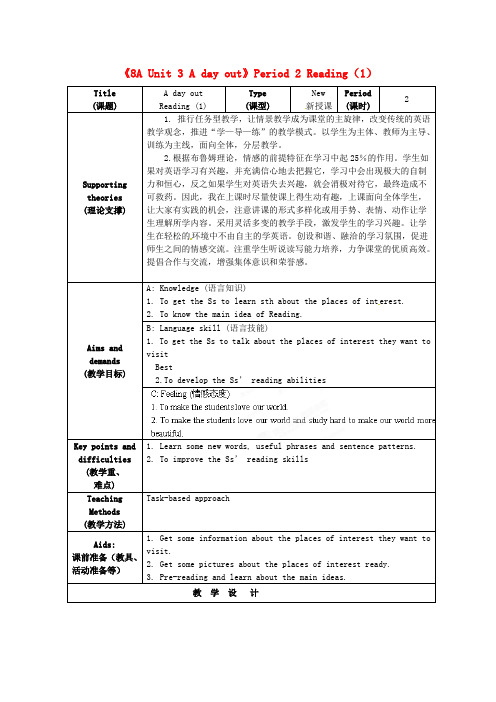
教学设 计
1. 预习课本 P40-41, 能根据音标正确拼读 P40-41 上 的生词。(会拼写、知词义)
课前延伸 (预习)
2. 重点预习课本 P40-41,尝试理解文章大意;听该页 录音,正确模仿课文中语音语调,较熟练地朗读课文。 3.解决疑难问题。找出课文中新出现的词组和句型结 构,查阅资料,初步了解其用法。
《8A Unit 3 A day out》Period 2 Reading(1)
Title (课题)
Supporting theories (理论支撑)
A day out Reading (1)
Type (课型)
New Period
新授课 (课时)
2
1. 推行任务型教学,让情景教学成为课堂的主旋律,改变传统的英语
Pictures and a passage) Reading 内容有进一步
学
One day, the sky was 的感性认识。
blue .My mom took me to The
Step II
World Park by coach. At the
内
Presentation
beginning the coach was on
are made of metal. We spent
the whole day visiting many places of interest. We
watched the song and dance parade. I made a homepage on
it on the internet.
- 1、下载文档前请自行甄别文档内容的完整性,平台不提供额外的编辑、内容补充、找答案等附加服务。
- 2、"仅部分预览"的文档,不可在线预览部分如存在完整性等问题,可反馈申请退款(可完整预览的文档不适用该条件!)。
- 3、如文档侵犯您的权益,请联系客服反馈,我们会尽快为您处理(人工客服工作时间:9:00-18:30)。
《8A Unit 3 A day out》Period 5 Grammar(2)
Title (课题) Online Travel
(Grammar)
Type
(课型)
New
新授课
Period
(课时)
5
Supporting theories (理论支持)
A.美国教育心理学家霍华德•加德纳提出的多元智能理论认为,多元情境化教学策略在初中英语教学中的应用,必然调动学生多种智能活动,学生在参与的过程中,体会到了学习英语的快乐,从而拉近了英语与学生的距离,激发了学生学习英语的兴趣,培养了学生自主学习的能力,有效地提高了课堂教学的成效。
本课是语法教学,以多元智能理论为依据,创设语境,结合实例和实物呈现教学内容,推进“学—导—练”的教学模式,以学生为主体、教师为主导、训练为主线,面向全体,分层教学,创设和谐、融洽的学习氛围,让学生自己体会归纳,帮助学生更好地掌握被动语态的用法,让学生在学习的过程中进行主动的学习,在学中乐,乐中学。
B.任务型教学(Task-based Teaching Approach)是指教师通过引导语言使学生在课堂上完成任务来进行的教学。
本课通过热身、呈现、操练、巩固和练习,将语言知识和语言技能结合起来,有助于培养学生综合的语言运用能力,促进学生积极参与语言交流活动,启发想象力和创造性思维,有利于发挥学生的主体性作用。
Aims and
demands
(教学目标)
Key points and
difficulties
(教学重、难点)
To learn how to use reflexive pronouns
Teaching Methods (教学方法) Task-based teaching approach Situational teaching method
Aids
课前准备(教具、
活动准备等)
Blackboard, computer
教学设计
课前延伸
1. Preview the new words of this part and try to
master the usage of them.
2. Complete the exercises of this part.(见学
案课前延伸)
让学生通过课前
自学,小组合作解决
预习中的一些问题,
为上课做准备。
Teaching Plan
(授课计划)
Studying Plan
(学习计划)
Aims
(设计意图)
课内探
究课内探究学
StepⅠ
Warm up
1. Check the answers on
the paper.
2. Give a brief
introduction in order to
present the new pattern.
温故知新,自然
导入新句型。
让学生
找出本节课的语言知
识点。
Step II
Presentation
1.Read the sentences and
find out the differences
of two sentences.
“Tom teaches me
english” and “ Tom
teaches himself
English”.
teach sb sth
teach oneself sth
2.Explain what they mean
in Chinese.
“Tom teaches me
english” and “ Tom
teaches himself
English”.
3.Ask the students to
find all the most phrases
in the sentences on pages
48 and underline them.
4.Reflexive grasp of
spelling rules . Explain
their roles .
Finish the table of
groups.
5.Work out the rule.
在语境中结合实
例和关键词呈现新语
言项目,有利于激发
学生兴趣。
教师引导、
学生合作探究。
(任务
驱动)
积极引导学生正
确定位并把握住本节
课的重点(反身代
词)。
(先不做出正误
判断,给学生设置一
个悬念,充分调动学
生探究问题的兴趣)
学生自己学会梳
理本节课的词组,初
步认识反身代词使用
方法。
以小组合作的
形式,让学生结合所
给的句子,找出反身
代词的拼写规则,并
在笔记本上总结。
(小组比赛)
让几个小组派出
一位代表在黑板上写
出总结的结论。
教师对各组写出
结论进行全面性的总
结,并帮学生编制拼
写的口诀。
6. Go through making sentences with some reflexive pronouns on page 47 and get them to know how to use reflexive pronouns .
让学生通过实际操作,进一步分析和理解反身代词的运用规则。
导Step III
Prac tice
1 Say something about
what we had learnt.
2 Explain the context of
the exercise on page 48
and 49. Before they start
to do it, review the use
of them. Ask the
students to say their
rules first. Tell the
students they should
use reflexive pronouns
to complete the
conversation.
2. Give them enough time
to complete it. If they
can’t work it out
correctly, they can work
in pairs.
3. Ask s tudents to read
their answers one by one
to see if most students
have understood the
structure.
以小组形式,请
代表复述反身代词的
运用规则。
采用小组互作合
作探究形式进行,有
利于降低难度,培养
合作精神,激发后进
生学习兴趣的。
及时发现学生的
存在问题,并及时进
行纠正。
练
Step IV
Production
Complete some exercises
1.Circle T or F and change
the correct answers.
2.Finish the sentences in
the blanks.
通过练习让学生
对本课所学内容加以
巩固.
用改错题加强操
作训练。
让学生以小
组的形式,分别找出
句子中的错误之处。
更好的激励学生团
队合作精神,并增强学生善于发现问题的能力。
课后提升
Step V
Assignment
1.Finish exercises left
on the paper.
2.Write reflexive
pronouns
by yourself.
3.完成《补充习题》
Grammar部分的练习
.
控制作业量,作
业既落实双基有重视
能力。
